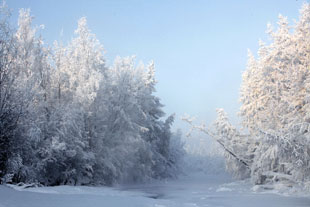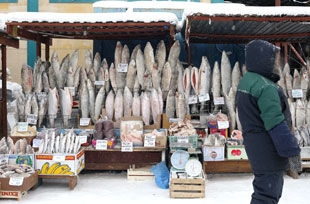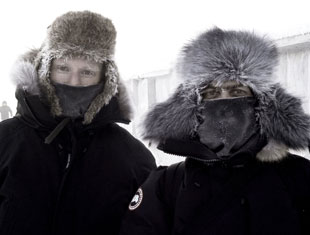![]() ‘I was fascinated by the idea that breath freezes at very low temperatures and makes a unique sound as the ice crystals form. It’s a very romantic concept and I simply couldn’t get it out of my head.
‘I was fascinated by the idea that breath freezes at very low temperatures and makes a unique sound as the ice crystals form. It’s a very romantic concept and I simply couldn’t get it out of my head.
‘No-one had previously succeeded in recording this phenomenon and even during my stay in Siberia, I sometimes started to think that the whole thing was, perhaps, just a myth…’
His fascination had taken German artist Juergen Staack to the coldest inhabited place on earth. Here, he hoped to take his art into new territory – and bring new territory into the world of art.
 The quest began with a television documentary about Oymyakon in the far east of Russia – and the mention of ‘ice whispering’, a phenomenon that supposedly occurs when people breathe and speak in extremely low temperatures. Exhaled breath instantly freezes, creating a crackling noise that follows the speaker ‘like a shadow’. Fascinated by the idea that words turn into crystals that have a sound of their own, Staack and artist colleague Thomas Neumann travelled to Yakutia in 2012 to witness it for themselves.
The quest began with a television documentary about Oymyakon in the far east of Russia – and the mention of ‘ice whispering’, a phenomenon that supposedly occurs when people breathe and speak in extremely low temperatures. Exhaled breath instantly freezes, creating a crackling noise that follows the speaker ‘like a shadow’. Fascinated by the idea that words turn into crystals that have a sound of their own, Staack and artist colleague Thomas Neumann travelled to Yakutia in 2012 to witness it for themselves.
Having begun his career working with images, Staack had lost faith in photography and migrated to sound: ‘For a long time, I had been working on transforming photographs into speech and sounds in order to make them more abstract and to create a new inherent value,’ he explains. ‘I trained as a photographer, but at the end of my training I was disillusioned by photography as a medium. Everyone consumes it, no one questions it and, within the flood of images around us, the individual photo no longer has any significance, any value.
‘For that reason, I let pictures become a kind of inspiration. I give people photos and let them talk about them – for example, I ask them to describe what they see. That aroused my interest in languages. The more obscure a language is, the more encrypted the description becomes. I then need a mediator into the world of thoughts for which this language is an expression.’
 Setting out on their expedition, the artists’ -35°C greeting at Yakutsk airport (in the capital city of the Sakha Republic) was just a chill compared to their actual destination – Oymyakon. In 1926, a recorded -71.2°C had earned it the title Pole of Cold.
Setting out on their expedition, the artists’ -35°C greeting at Yakutsk airport (in the capital city of the Sakha Republic) was just a chill compared to their actual destination – Oymyakon. In 1926, a recorded -71.2°C had earned it the title Pole of Cold.
From the airport, the Kolyma Highway (‘Road of Bones’) took them 700km north-east to the village of Oymyakon, which lies in a wind-protected valley that prevents the cold air from escaping, thus causing extremely low temperatures in winter.
‘During our first days there it was -48°C, which was – don’t laugh – apparently too warm for ice whispering,’ Staack says. ‘It meant that we had to correct the temperature that had previously been considered necessary for ice whispering, 45°C, downwards. As we couldn’t hear any noise, we started to get a bit nervous. Although there had been reports of ice whispering, no recordings actually existed.’
Waiting for the opportunity to record the ‘whisper of the stars’, Staack made other audio and video recordings in readiness for a planned exhibition – including conversations with a local meteorologist and inhabitants who talked about their experience of ice whispering.
‘I spent my time collecting material for my picture descriptions,’ he says. ‘In most cases, the people in my interviews initially focus on the description, but they very soon start to tell stories and sing songs – and the folklore of a people unfolded before my eyes.
 ‘Some of them were not even aware of the phenomenon, while others reported how they had experienced it when they were young,’ Staack says. ‘The sound seems to have become increasingly seldom. For me, this example makes global warming tangible. A nearby coal-fired power station might also play a part in preventing the temperatures in Oymyakon from falling quite as low as they did some years ago.’
‘Some of them were not even aware of the phenomenon, while others reported how they had experienced it when they were young,’ Staack says. ‘The sound seems to have become increasingly seldom. For me, this example makes global warming tangible. A nearby coal-fired power station might also play a part in preventing the temperatures in Oymyakon from falling quite as low as they did some years ago.’
In due course the artists’ endeavours and patience were rewarded: ‘We went out every night to make recordings, and on one particular night the temperature had dropped even further, to -57°C. And suddenly: there it was…
‘Our breath and speech produced a noise, a jangling sound, a kind of rustling crackle that reverberated after each word and each breath, and followed it like a shadow,’ Staack recalls. ‘Against the light, we could see our breath billowing and vortexing.’
The next night, the phenomenon had passed – it had become warmer.
Whispers in the galerie
 The sound recordings Staack brought in from the cold formed the basis of an exhibition entitled SAKHA at the Konrad Fischer Galerie in Berlin.
The sound recordings Staack brought in from the cold formed the basis of an exhibition entitled SAKHA at the Konrad Fischer Galerie in Berlin.
A year in the making, the exhibition began with a white room where a video conveyed the tranquillity of the landscape and life in Oymyakon. On the floor, four loudspeakers were arranged in a square. ‘I had noticed that snow in Oymyakon sounds different at each temperature,’ Staack explains.
‘I had walked around and recorded the crunching of my steps in the snow. When visitors stand in the square, they can hear a person walking around them through the deep snow.’
On one wall, Cyrillic letters describing the whisper of the stars were painted. Visitors then moved into a darkened room where Valery Vinokurov describes the whisper of the stars, while his breath creates white turbulences and veils as it dissipates into the blackness.
‘Valery is a geologist who lives in Oymyakon and who describes the phenomenon in his native Yakut,’ Staack explains, ‘with illustrative descriptions of temperature such as “so cold that the birds freeze to death in flight and fall to the ground”.
Another dark room is then given over entirely to the whisper of the stars itself – which had now been recorded for the very first time.
Inevitably, the recording equipment shared the challenges the severe temperatures presented Staack and Neumann. Critical to the mission was the choice of microphones.
‘We gathered as much information as possible before we left and spoke to a lot of experts, including Sennheiser,’ Staack recalls. ‘Of course, no piece of technical equipment has ever been tested under such extreme conditions, and the internet is full of the wildest stories of displays shattering and cables snapping in the cold. We relied on both quality and quantity and took a lot of equipment with us to make sure we always had a replacement at hand if something broke down. We used equipment and accessories from as many different manufacturers as possible, took special equipment with us wherever possible and combined both analogue and digital equipment.’
In fact, some of these stories were actually true…
 ‘Standard cables did indeed break in the cold,’ he reports. ‘I once went outside in a hurry and at this very moment the cables froze rigid and couldn’t be stored anywhere. So I had to go back inside and carefully thaw them out. On the digital camera, the crystals in the displays began to move extremely slowly before the display failed completely. The camera still worked however. On the analogue camera, I noticed the shutter slowly starting to freeze up.
‘Standard cables did indeed break in the cold,’ he reports. ‘I once went outside in a hurry and at this very moment the cables froze rigid and couldn’t be stored anywhere. So I had to go back inside and carefully thaw them out. On the digital camera, the crystals in the displays began to move extremely slowly before the display failed completely. The camera still worked however. On the analogue camera, I noticed the shutter slowly starting to freeze up.
‘So we had to develop our own techniques – we carried the battery packs and recorders close to our body and pulled the cables through our sleeves. Anything that had to be used outside was not taken out until shortly before the recordings were made and was switched on indoors before we went out. It was not only that it was impossible to operate small switches while wearing thick gloves, some of the equipment worked perfectly when it was switched on indoors but refused to start up when we tried to switch it on at -50°C…
One of the stalwart equipment choices was a Sennheiser MKH 8060 RF condenser microphone, which now shares the accolade of having made an historic recording.
‘We succeeded in recording the whisper of the stars, that was the greatest success for me,’ Staack reflects. ‘I would have liked to have made a second recording, but the weather was kind to us only once. We met many wonderful people from a unique culture, people with fascinating traditions and ancient beliefs. One can really get homesick for Yakutia…’
More: www.sennheiser.com